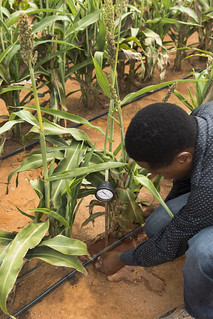Meera Shah, Project Administrator at Malabo Montpellier Panel, discusses the critical role of digital technologies in understanding the health of soil.
Soils are the foundation of life, as they sustain humans, plants and animals for present and future generations. Protecting and sustainably managing soil is therefore of paramount importance, particularly in the context of climate change, deforestation and loss of biodiversity.
Africa’s soils are incredibly diverse; they range from highly acidic and harshly weathered, to dark and moderately leached soils with rich organic topsoil. For African soils to continue delivering high crop yields while serving a range of environmental functions, it is essential that they are managed carefully.
The health of soils can be measured by their physical, chemical and biological characteristics. A healthy soil has a mix of particle sizes, a strong structure, good permeability and the capacity to retain water. Healthy soils are also rich in soil organic matter, plant nutrients and biota.
For farmers, achieving the right balance between nutrients, cost of inputs (labor, water and fertilizers), and minimizing environmental impacts is as essential as it is difficult.

Soil profile of a sandy, Gypsic Aquisalids from Abu Dhabi, UAE. These are very sandy, saline soils with gypsum. Photo by John A. Kelley, USDA Natural Resources Conservation Service.
Being soil smart
Fortunately, there is a growing portfolio of digital technologies designed in, and for Africa, that simplify the process of visualizing, understanding and improving soil fertility. The development of sensors, drones and smart irrigation powered by the Internet of Things (IoT) is disrupting the way that decisions are made, and how inputs are applied.
Sensors placed around the farm or on farm equipment enable farmers to diligently and remotely monitor humidity, temperature, pH, moisture and nutrients. Sensors transmit the data to larger databases and servers either via phone networks (e.g. Kenya’s Ujuzi Kilimo sensor), or wirelessly via Wi-Fi, GSM or satellites (e.g. Nigeria’s Zenvus SmartFarm) where more complex computations and machine learning applications are used to generate recommendations.
The sensors can also be connected to an automated drip irrigation system via cloud-based analytics, to ensure that soil humidity does not fall beyond a minimum threshold. This makes the irrigation process more efficient and allows farmers to spend time on other tasks. By programming irrigation systems to release water during times of least evapotranspiration, such as at night, farmers can significantly improve their water footprint. As this technology develops further, the precise application of fertilizers based on the needs of the soil will also be optimized.
Ground sensors can be combined with aerial technologies to reinforce data. Remote sensing and Geographic Information Systems (GIS) tools have transformed how spatial variation, soil quality and soil degradation are assessed, and how interventions are applied. Advances in satellite technology are also being applied to measure and visualize soil moisture, organic matter, texture, salinity and iron content. The Africa Soil Information Service (AfSIS) program models soil moisture available for plant growth to determine potential yields.

Field research of iAGRI-scholar Mahinda Athuman regarding drip irrigation and climate change mitigation for sorghum grown in arid to semi-arid regions of central Tanzania, Africa.
Satellites are key in providing timely weather information, which allows farmers to decide whether irrigation or other inputs will be required. In 2018, the Kenya Agriculture and Livestock Research Organization launched a pilot agricultural observatory platform in partnership with the World Bank to enhance access to high-resolution geospatial agro-meteorology data. The platform uses Big Data, artificial intelligence and machine learning to provide more accurate, timely and reliable weather data to enable better decision-making among farmers. Likewise, Morocco launched a satellite in 2018 to monitor agricultural activities, prevent and manage natural disasters, monitor environmental trends and desertification. Ethiopia will launch its first earth observatory satellite in September 2019, in partnership with China, to collect data on changes in climate and weather-related phenomena.
The availability of real-time data and information allows farmers to identify and manage potential problems, even at an individual crop level, in a timely manner. Drones fitted with hyper-spectral imaging cameras can be used for precision aerial surveillance to assess nutrient deficiencies in crops and soils. Alternatively, drones can be used to apply precise amounts of agrochemicals – reducing excessive use, cost and pollution, as well as drudgery and risks to human health.
In order to ensure that farmers gain the most from these technologies, it is necessary that they are aware of them and can easily understand the information provided. Although smart technologies are rapidly becoming more affordable, they tend to remain out of reach for Africa’s smallholder farmers. For instance, the SmartFarm kit costs between US$200 to US$650.
It is therefore essential that public investments are made to create awareness about the technologies and facilitate their access, without which the benefits of digital technologies will be severely limited. Improving digital literacy is fundamental to empower farmers to use the information.
Arguably the most impactful technology within the suite of digital solutions for agriculture so far is the mobile phone. Not only does it create a direct point of contact with a farmer, a mobile phone can also be used to collect, collate, process, and transmit customized and real time data and information, all at a touch of a button and at any time of the day.
Without the appropriate infrastructure to connect farmers in the first place, the full benefits of digital technologies will not reach them and so will not be fully harnessed within the agricultural sector.



